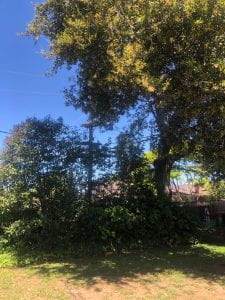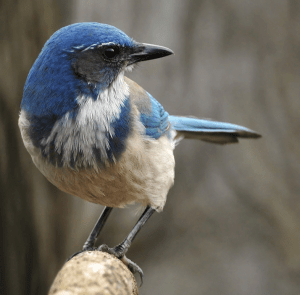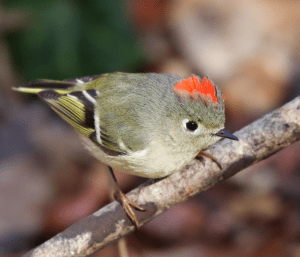Date: March 31st, 2020 – https://ebird.org/checklist/S66538383
Location: South Los Altos, CA – 37.383, -122.114 – Elevation: 48m/157ft
Site Description: This week, I went birding along my walk in South Los Altos, CA. I spent 130 minutes (a little over 2 hours) walking 3.7 miles in a loop around my neighborhood. The topography of this region is overall very flat since it is a residential area, but has lots of foliage as compared to the more people-heavy neighborhoods nearby. The walk I took is lined by many taller trees, hedges and shrubs outside of peoples homes, and small bushes that I often hear movement in. One struggle that I am having with identifying birds is that I can hear them in bushes and trees before I see them and then when I get closer or when I get a quick look at them, they immediately fly away. I am also having some trouble identifying birds when they are flying above because I cannot get a very clear look at their coloration patterns, although many of the soaring birds I’ve seen near my house in the recent weeks have somewhat distinct morphology. As mentioned in class, I am seeing many swallow species with the migration season upon us, but we did not see too many different swallows in class so I am having to look many times at my Sibley guide and the individual bird to get an idea of which species I am seeing. This time, I believe I saw a group of Tree Swallows, which I had never seen before and has a bright blue coloration pattern – at first glance I thought it may be a bluebird or Jay of some kind. However, the individuals with a striking blue-ish coloration were in the same grouping as those with a more dull grey-black coloration, but the same body shape.¹ This led me to conclude that I was seeing male and female tree swallows. Their flight pattern was consistent with that of a swallow and I could observe some of their fly-catching behavior, which was incredible to see. Other bird species I saw that were more commonly spotted on our pre-Spring Break outings included the American Crow (19 individuals) and the Common Raven (8). One species I was excited to see (and have seen everyday that I have taken a walk) is the Anna’s Hummingbird. I am glad we were able to see so many of these individuals during our class because now I am able to appreciate their coloration and flight patterns when I look more closely and can differentiate between the Anna’s Hummingbird and the Allen’s Hummingbird quickly. Their hovering behavior is so distinct and very cool to observe. Particularly because hummingbirds are commonly seen in backyards and suburban areas,² I am glad I am able to see so many individuals even though we are not venturing to Marin any longer. Another species I was able to spot was the California Scrub-Jay, which I have seen intermittently in my backyard moving around in the trees and sometimes in planters. I am typically able to quickly identify this bird based on their long tails and hunched posture along with their blue backside and grey underbelly. Scrub-Jays are often found in backyards, pastures and orchards where they are able to forage. They are usually found in lower and drier habitats than the Stellar’s Jay,3 which I was also able to spot this week. See images below for views of the path I walked along with an image of a Tree Swallow, one of an Anna’s Hummingbird, and one of a California Scrub-Jay (I tried to find images that most closely resembled the morphology and coloration I saw in the field).
Species Account: Ruby-crowned Kinglet – Regulus calendula (Passeriformes > Regulidae) Kinglets are quite small songbirds with relatively large heads as compared to the rest of their body, almost no neck between the head and body regions, and thin tails. They have very small, thin bills that are straight with no curvature. This bill shape is indicative of their diet: this species feeds largely on small insects. They typically feed on whatever is readily available, including small beetles, flies, leafhoppers, true bugs, caterpillars, and many others.4 In winter, they may also eat some berries and seeds. The feeding behavior of the Ruby-crowned Kinglet is highly active as they are constantly moving from treetops to low brush, examining foliage, twigs, and the limbs of trees for insects. They will often exhibit a hovering behavior while taking items from foliage and they can sometimes be spotted catching insects in mid-air! Ruby-crowned Kinglets can vary widely in color between individuals with some appearing more drab and having a continuous color pattern throughout their body while others have more pronounced body color and a striking reddish coloration on the head. In general, Ruby-crowned Kinglets are olive-green birds with a prominent white eyeing and a noticeable white wingbar.5 This white wing bar is particularly noticeable because it lies next to a black wingbar. The “ruby crown” of the male is not always visible, but often can be spotted when the bird is moving. One helpful birding tip I read is that the plumage is similar to that of a Hutton’s Vireo, but has a tiny bill that is a nice identifier between the two.6 For a birder that is a bit newer to the practice of birding (like myself), the behavior of the Ruby-crowned Kinglet lends itself nicely to being spotted because they tend to be restless – which now that I am thinking about it, may be disadvantageous for avoiding predation although it’s advantageous for our own identification purposes. They tend to be lively, acrobatic birds that move quickly through foliage at the lower and middle levels (around eye height!). They are almost always flicking their wings while they are flying, so they can be noisy. The Ruby-crowned Kinglet gives off an energetic vibe as it moves very quickly. Their song resembles an excited musical chattering. They are most commonly found in a habitat containing tall, dense conifer forests that may include spruce, fir, and tamarack trees. Particularly during migration, they can be found in shrubby habitats, parks, and suburbs, which is convenient for our birding endeavors. Both parents of the Ruby-crowned Kinglet feed nestlings and the young leave the nests around 16 days after hatchling. Kinglets migrate a little earlier in the fall and later spring where peak migratory periods are October and April. The distribution of the Ruby-crowned Kinglet in the United States can be seen in the image below, where blue indicates where they can be found in the winter months and pink corresponds to common breeding grounds. Another identification tip that I found helpful while birding this past week was that the song of the Ruby-crowned Kinglet is improbably loud and musical for such a small bird. The call is so loud that many observers who hear one before seeing it often assume it is a much larger species. The song is quite long, consisting of whistles and short clear notes.7 It was easy to identify the Ruby-crowned Kinglets that I saw during my walk on Wednesday because they were flitting around low shrubbery and I could hear them before I saw them. After patiently waiting with my binoculars for them to reveal themselves, I could see their distinctive round body shapes that lack a neck and their small bill. At first glance, I thought the Kinglets may be some sort of Wren (perhaps a House Wren) and the coloration was difficult to make out at first glance so their body almost resembled that of a Dark-eyed Junco. However, when I was able to get closer and when they moved into a position more favorable to observe their distinct coloration, the combination of their call, body shape, and coloration made it clear that I was seeing a Ruby-crowned Kinglet. I was disappointed I was only able to observe the bright red “ruby crown” on one individual, but I believe they will be much easier to identify from now on after seeing the other individuals with slightly less distinctive morphology. I will continue to look for Ruby-crowned Kinglets in the shrubbery and all kinds of trees that surround me on my daily walks, and hope to witness some Kinglets when I go birding around my local parks. See below images for a U.S. distribution map and two views of the Ruby-crowned Kinglet (where the distinctive “ruby crown” is visible)
Narrative: I departed my house, binoculars in hand, at 11:10am on March 31st and stopped birding 130 minutes later (for a total time of two hours and 10 minutes). I spent two hours walking along a loop that began at my home and proceeded through a residential area and two small parks. The walk was 3.7 miles long. I witnessed seven bird taxa in this time period, although some birds I did not note on my eBird because I was not able to get a good enough look at them before they flew away. This was a particularly common issue when I was walking through the parks. I saw a massive amount of American Crows and Ravens flying above and in the very tall trees in the parks. The main challenge I had this week was that I would hear the birds moving through shrubbery, trees, hedges, and bushes, but was not able to identify them before they flew away. This was also an issue I had when I would see birds on the path ahead of me and tried to note their body shape from where I was currently standing, but once I tried to get closer or move to a side where I could make out their coloration or beak shape, they would fly away. The weather on this day was beautiful and sunny with a high of 65°F and a low of 44°F.8 As was discussed during our weekly check-in meetings, I am hoping to identify more birds that should be prevalent during migration and I am hoping to begin identifying birds based on call alone (or at least gaining a better sense for the bird based on the call and confirming my suspicions based on what I am seeing). I am particularly hoping to keep an eye out for more swallows (especially the Barn Swallow), Hutton’s Vireos, some sort of woodpecker species, and ideally some sort of hawk species. In the future, I will continue to bird in parks while I am walking because I believe this was a nice place to see a high volume of birds, particularly since there are fewer people out during this time. Because I am one of the only people in the park, I believe more birds are gathering without the fear of avoiding people and are less flighty and scared when I come closer.
Additional Photos & Media: See below photos for additional images the foliage alongside my walk on March 31st.
Sources:
¹ “Tree Swallow Identification, All About Birds, Cornell Lab of Ornithology.” , All About Birds, Cornell Lab of Ornithology, www.allaboutbirds.org/guide/Tree_Swallow/id.
² “Anna’s Hummingbird Identification, All About Birds, Cornell Lab of Ornithology.” , All About Birds, Cornell Lab of Ornithology, www.allaboutbirds.org/guide/Annas_Hummingbird/id.
3 “California Scrub-Jay Identification, All About Birds, Cornell Lab of Ornithology.” , All About Birds, Cornell Lab of Ornithology, www.allaboutbirds.org/guide/California_Scrub-Jay/id.
4 “Ruby-crowned Kinglet.” Audubon, 29 Dec. 2019, “Mourning Dove.” Audubon, 16 Dec. 2019, www.audubon.org/field-guide/bird/mourning-dove.
5 “Ruby-crowned Kinglet Identification, All About Birds, Cornell Lab of Ornithology.” Overview, All About Birds, Cornell Lab of Ornithology, www.allaboutbirds.org/guide/Ruby-crowned_Kinglet/id.
6 “Ruby-crowned Kinglet.” eBird, The Cornell Lab, https://ebird.org/species/ruckin.
7 Regulus calendula L 4 ¼” (11cm). “Ruby-Crowned Kinglet.” Bird Watcher’s Digest, 25 Sept. 2017, www.birdwatchersdigest.com/bwdsite/learn/identification/thrushes-allies/ruby-crowned-kinglet.php.
8 Pelmorex Weather Networks Inc. “Los Altos, CA Window._config.masthead_has_content = True;” The Weather Network, www.theweathernetwork.com/us/last-24-hours/california/los-altos.San Rafael, CA Monthly Weather.”











